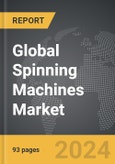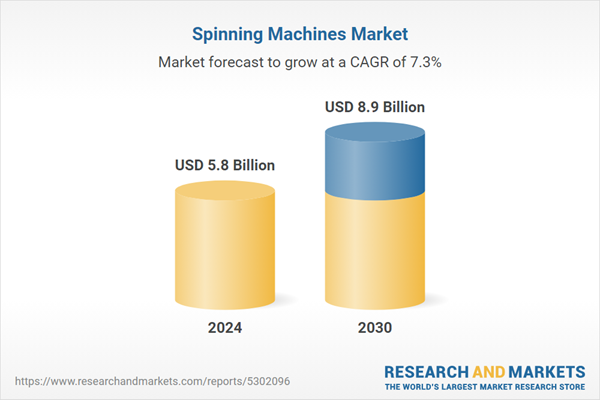Global Spinning Machines Market - Key Trends and Drivers Summarized
Why Are Spinning Machines Crucial to the Modern Textile Industry?
Spinning machines are the backbone of the textile manufacturing process, playing a vital role in the production of yarn, which is the primary component in fabric-making. But what makes spinning machines so essential to the textile industry? The primary function of these machines is to transform raw materials like cotton, wool, or synthetic fibers into fine strands of yarn through various processes such as drawing, twisting, and winding. This process, known as spinning, ensures that the fibers are aligned and compacted into strong, uniform yarns suitable for weaving or knitting. The efficiency and precision of spinning machines directly impact the quality of the yarn produced, which in turn affects the quality of the fabrics and garments created from that yarn. From mass production of textiles for clothing to specialized applications like industrial fabrics and high-performance materials, spinning machines are indispensable to ensuring consistency, strength, and durability in the final products. The development of automated and high-speed spinning machines has revolutionized the textile industry by dramatically increasing production capacity and reducing the labor intensity associated with traditional spinning methods. In modern textile mills, spinning machines operate continuously, producing large volumes of yarn with minimal human intervention. These advancements have also enabled the production of more complex yarns, including blended fibers that combine the properties of different materials, allowing manufacturers to cater to a wide range of applications and consumer preferences.How Are Technological Advancements Shaping the Evolution of Spinning Machines?
The evolution of spinning machines has been heavily influenced by technological advancements that have increased efficiency, automation, and flexibility in the production of yarn. In the early days of textile production, spinning was a manual, labor-intensive process, but with the advent of the Industrial Revolution, mechanized spinning machines transformed the industry by dramatically improving productivity. Today, the spinning machine industry is witnessing further innovations, with advanced automation technologies driving the next wave of transformation. Computerized systems now allow for precise control over every stage of the spinning process, from fiber blending to tension control and yarn winding. These machines are equipped with sensors and real-time monitoring systems that detect irregularities in yarn quality, allowing for immediate adjustments to ensure consistent output. Additionally, modern spinning machines are increasingly designed to be energy-efficient and eco-friendly, which aligns with the textile industry's growing emphasis on sustainability. Energy-efficient motors, optimized airflow systems, and intelligent machine design reduce power consumption, helping manufacturers lower their operational costs and minimize their environmental footprint. Some spinning machines are also equipped with waste recycling capabilities, reducing the amount of fiber waste generated during the spinning process. These innovations have not only made spinning machines more sustainable but also more versatile. For example, advanced rotor and air-jet spinning technologies are now widely used in the production of high-strength and elastic yarns, which are essential for creating performance fabrics used in sportswear and technical textiles. The integration of digital technologies, such as IoT (Internet of Things) and AI-driven predictive maintenance, is further enhancing the operational efficiency of spinning machines, allowing for more precise, automated production with minimal downtime.What Are the Key Considerations for Choosing and Using Spinning Machines in Textile Production?
When selecting spinning machines for textile production, manufacturers must consider several key factors to ensure that the equipment meets their specific needs and operational goals. The first consideration is the type of material being spun, as different fibers - whether natural like cotton or wool, or synthetic like polyester or nylon - require specific types of machines and settings. Spinning machines are available in various configurations, such as ring spinning, open-end (or rotor) spinning, and air-jet spinning, each suited to different types of fibers and yarn properties. For example, ring spinning machines are known for producing high-quality, strong yarns with excellent texture, making them ideal for fine garments. In contrast, open-end spinning machines are faster and more cost-efficient, though they produce slightly coarser yarn, which is often used in denim or upholstery fabrics. Another crucial consideration is production capacity. Textile manufacturers need to balance machine speed and efficiency with the desired output quality. High-speed spinning machines are ideal for mass production, but they must maintain consistent yarn tension and prevent breakage during the process. Quality control features, such as automatic doffing (removal of finished yarn packages) and yarn breakage detection systems, are important for maintaining high production standards. Additionally, the ability to handle various fiber blends and create custom yarn compositions is increasingly important, as manufacturers seek to meet the growing demand for innovative and sustainable fabrics. Maintenance and ease of operation are also critical factors when choosing a spinning machine. Machines that offer easy access for cleaning and maintenance can reduce downtime and prolong the equipment's lifespan. Many modern spinning machines are designed with modular components, allowing for easier upgrades and repairs, which improves operational flexibility. Moreover, the adoption of automation in spinning machines has significantly reduced the need for manual intervention, allowing operators to focus more on quality control and less on machine operation.What Factors Are Driving the Growth of the Spinning Machines Market?
The growth in the spinning machines market is driven by several factors that reflect the rapid changes in the textile industry and the increasing demand for high-performance fabrics and sustainable production practices. One of the most significant drivers is the growing demand for textiles across multiple sectors, including fashion, home furnishings, and industrial applications. As global populations grow and urbanization increases, the demand for affordable and high-quality clothing is rising, pushing textile manufacturers to invest in advanced spinning machines that can increase production capacity and improve yarn quality. Additionally, the rise of fast fashion has contributed to the need for more efficient production processes, which is further accelerating the adoption of high-speed and automated spinning machines. Another major factor driving market growth is the increasing demand for sustainable and eco-friendly textile production. With heightened awareness of the environmental impact of textile manufacturing, there is a growing push toward reducing waste, conserving energy, and using sustainable materials. This shift is prompting manufacturers to invest in energy-efficient spinning machines that minimize resource consumption while maintaining high output quality. The use of recycled fibers and biodegradable materials is also gaining traction, and spinning machines that can handle these materials are in high demand as textile manufacturers strive to meet sustainability goals. Technological advancements, particularly in automation and digitalization, are also key growth drivers in the spinning machine market. The integration of IoT, AI, and machine learning in spinning machines has allowed manufacturers to enhance production efficiency, improve yarn consistency, and reduce operational costs. Predictive maintenance systems powered by AI help prevent machine breakdowns, ensuring smoother production processes and reducing downtime. Moreover, the ability to produce high-performance yarns, such as those used in sportswear, medical textiles, and technical fabrics, is expanding the market for specialized spinning machines. These factors - ranging from the growing demand for textiles and sustainable production practices to technological innovations and the need for high-performance fabrics - are collectively driving the global spinning machine market's growth and shaping its future trajectory.Report Scope
The report analyzes the Spinning Machines market, presented in terms of market value (USD Thousand). The analysis covers the key segments and geographic regions outlined below.Segments
Type (Ring Spinning, Rotor Spinning, Other Types); Material Type (Synthetic, Natural, Other Material Types); End-Use (Textile, Clothing, Other End-Uses).Geographic Regions/Countries
World; United States; Canada; Japan; China; Europe (France; Germany; Italy; United Kingdom; Spain; Russia; and Rest of Europe); Asia-Pacific (Australia; India; South Korea; and Rest of Asia-Pacific); Latin America (Argentina; Brazil; Mexico; and Rest of Latin America); Middle East (Iran; Israel; Saudi Arabia; United Arab Emirates; and Rest of Middle East); and Africa.Key Insights:
- Market Growth: Understand the significant growth trajectory of the Ring Spinning Machines segment, which is expected to reach $3.8 Billion by 2030 with a CAGR of a 7.3%. The Rotor Spinning Machines segment is also set to grow at 7.9% CAGR over the analysis period.
- Regional Analysis: Gain insights into the U.S. market, valued at $1.5 Billion in 2024, and China, forecasted to grow at an impressive 10.7% CAGR to reach $2.1 Billion by 2030. Discover growth trends in other key regions, including Japan, Canada, Germany, and the Asia-Pacific.
Report Features:
- Comprehensive Market Data: Independent analysis of annual sales and market forecasts in USD from 2024 to 2030.
- In-Depth Regional Analysis: Detailed insights into key markets, including the U.S., China, Japan, Canada, Europe, Asia-Pacific, Latin America, Middle East, and Africa.
- Company Profiles: Coverage of major players such as A.T.E., Itema, Kirloskar Toyota Textile Machinery, Lakshmi Machine Works, Marzoli Spinning Solutions and more.
- Complimentary Updates: Receive free report updates for one year to keep you informed of the latest market developments.
Why You Should Buy This Report:
- Detailed Market Analysis: Access a thorough analysis of the Global Spinning Machines Market, covering all major geographic regions and market segments.
- Competitive Insights: Get an overview of the competitive landscape, including the market presence of major players across different geographies.
- Future Trends and Drivers: Understand the key trends and drivers shaping the future of the Global Spinning Machines Market.
- Actionable Insights: Benefit from actionable insights that can help you identify new revenue opportunities and make strategic business decisions.
Key Questions Answered:
- How is the Global Spinning Machines Market expected to evolve by 2030?
- What are the main drivers and restraints affecting the market?
- Which market segments will grow the most over the forecast period?
- How will market shares for different regions and segments change by 2030?
- Who are the leading players in the market, and what are their prospects?
Some of the 42 major companies featured in this Spinning Machines market report include:
- A.T.E.
- Itema
- Kirloskar Toyota Textile Machinery
- Lakshmi Machine Works
- Marzoli Spinning Solutions
- Murata Machinery
- Rieter
- Saurer
- Savio Macchine Tessili
- Trützschler
Table of Contents
Companies Mentioned (Partial List)
A selection of companies mentioned in this report includes, but is not limited to:
- A.T.E.
- Itema
- Kirloskar Toyota Textile Machinery
- Lakshmi Machine Works
- Marzoli Spinning Solutions
- Murata Machinery
- Rieter
- Saurer
- Savio Macchine Tessili
- Trützschler
Table Information
| Report Attribute | Details |
|---|---|
| No. of Pages | 93 |
| Published | March 2025 |
| Forecast Period | 2024 - 2030 |
| Estimated Market Value ( USD | $ 5.8 Billion |
| Forecasted Market Value ( USD | $ 8.9 Billion |
| Compound Annual Growth Rate | 7.3% |
| Regions Covered | Global |









